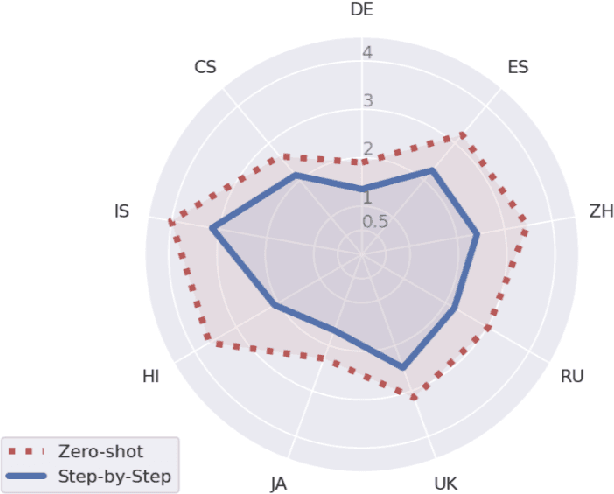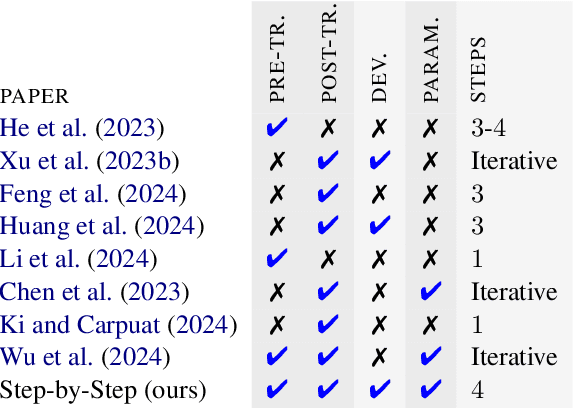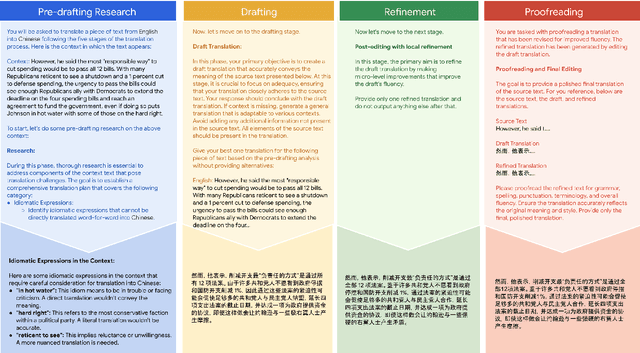Colin Cherry
Dima
SSA-COMET: Do LLMs Outperform Learned Metrics in Evaluating MT for Under-Resourced African Languages?
Jun 05, 2025Abstract:Evaluating machine translation (MT) quality for under-resourced African languages remains a significant challenge, as existing metrics often suffer from limited language coverage and poor performance in low-resource settings. While recent efforts, such as AfriCOMET, have addressed some of the issues, they are still constrained by small evaluation sets, a lack of publicly available training data tailored to African languages, and inconsistent performance in extremely low-resource scenarios. In this work, we introduce SSA-MTE, a large-scale human-annotated MT evaluation (MTE) dataset covering 13 African language pairs from the News domain, with over 63,000 sentence-level annotations from a diverse set of MT systems. Based on this data, we develop SSA-COMET and SSA-COMET-QE, improved reference-based and reference-free evaluation metrics. We also benchmark prompting-based approaches using state-of-the-art LLMs like GPT-4o and Claude. Our experimental results show that SSA-COMET models significantly outperform AfriCOMET and are competitive with the strongest LLM (Gemini 2.5 Pro) evaluated in our study, particularly on low-resource languages such as Twi, Luo, and Yoruba. All resources are released under open licenses to support future research.
Gemma 3 Technical Report
Mar 25, 2025Abstract:We introduce Gemma 3, a multimodal addition to the Gemma family of lightweight open models, ranging in scale from 1 to 27 billion parameters. This version introduces vision understanding abilities, a wider coverage of languages and longer context - at least 128K tokens. We also change the architecture of the model to reduce the KV-cache memory that tends to explode with long context. This is achieved by increasing the ratio of local to global attention layers, and keeping the span on local attention short. The Gemma 3 models are trained with distillation and achieve superior performance to Gemma 2 for both pre-trained and instruction finetuned versions. In particular, our novel post-training recipe significantly improves the math, chat, instruction-following and multilingual abilities, making Gemma3-4B-IT competitive with Gemma2-27B-IT and Gemma3-27B-IT comparable to Gemini-1.5-Pro across benchmarks. We release all our models to the community.
Leveraging Domain Knowledge at Inference Time for LLM Translation: Retrieval versus Generation
Mar 06, 2025Abstract:While large language models (LLMs) have been increasingly adopted for machine translation (MT), their performance for specialist domains such as medicine and law remains an open challenge. Prior work has shown that LLMs can be domain-adapted at test-time by retrieving targeted few-shot demonstrations or terminologies for inclusion in the prompt. Meanwhile, for general-purpose LLM MT, recent studies have found some success in generating similarly useful domain knowledge from an LLM itself, prior to translation. Our work studies domain-adapted MT with LLMs through a careful prompting setup, finding that demonstrations consistently outperform terminology, and retrieval consistently outperforms generation. We find that generating demonstrations with weaker models can close the gap with larger model's zero-shot performance. Given the effectiveness of demonstrations, we perform detailed analyses to understand their value. We find that domain-specificity is particularly important, and that the popular multi-domain benchmark is testing adaptation to a particular writing style more so than to a specific domain.
SMOL: Professionally translated parallel data for 115 under-represented languages
Feb 17, 2025Abstract:We open-source SMOL (Set of Maximal Overall Leverage), a suite of training data to unlock translation for low-resource languages (LRLs). SMOL has been translated into 115 under-resourced languages, including many for which there exist no previous public resources, for a total of 6.1M translated tokens. SMOL comprises two sub-datasets, each carefully chosen for maximum impact given its size: SMOL-Sent, a set of sentences chosen for broad unique token coverage, and SMOL-Doc, a document-level source focusing on a broad topic coverage. They join the already released GATITOS for a trifecta of paragraph, sentence, and token-level content. We demonstrate that using SMOL to prompt or fine-tune Large Language Models yields robust ChrF improvements. In addition to translation, we provide factuality ratings and rationales for all documents in SMOL-Doc, yielding the first factuality datasets for most of these languages.
Overestimation in LLM Evaluation: A Controlled Large-Scale Study on Data Contamination's Impact on Machine Translation
Jan 30, 2025



Abstract:Data contamination -- the accidental consumption of evaluation examples within the pre-training data -- can undermine the validity of evaluation benchmarks. In this paper, we present a rigorous analysis of the effects of contamination on language models at 1B and 8B scales on the machine translation task. Starting from a carefully decontaminated train-test split, we systematically introduce contamination at various stages, scales, and data formats to isolate its effect and measure its impact on performance metrics. Our experiments reveal that contamination with both source and target substantially inflates BLEU scores, and this inflation is 2.5 times larger (up to 30 BLEU points) for 8B compared to 1B models. In contrast, source-only and target-only contamination generally produce smaller, less consistent over-estimations. Finally, we study how the temporal distribution and frequency of contaminated samples influence performance over-estimation across languages with varying degrees of data resources.
On the Implications of Verbose LLM Outputs: A Case Study in Translation Evaluation
Oct 01, 2024Abstract:This paper investigates the impact of verbose LLM translations on evaluation. We first demonstrate the prevalence of this behavior across several LLM outputs drawn from the WMT 2024 general shared task on machine translation. We then identify the primary triggers of verbosity, including safety, copyright concerns, and insufficient context in short input queries. Finally, we show that ignoring this behavior unfairly penalizes more verbose LLMs according to both automatic and human evaluations, highlighting the need to address this issue for more accurate future evaluations.
Translating Step-by-Step: Decomposing the Translation Process for Improved Translation Quality of Long-Form Texts
Sep 10, 2024



Abstract:In this paper we present a step-by-step approach to long-form text translation, drawing on established processes in translation studies. Instead of viewing machine translation as a single, monolithic task, we propose a framework that engages language models in a multi-turn interaction, encompassing pre-translation research, drafting, refining, and proofreading, resulting in progressively improved translations. Extensive automatic evaluations using Gemini 1.5 Pro across ten language pairs show that translating step-by-step yields large translation quality improvements over conventional zero-shot prompting approaches and earlier human-like baseline strategies, resulting in state-of-the-art results on WMT2024.
Don't Throw Away Data: Better Sequence Knowledge Distillation
Jul 15, 2024Abstract:A critical component in knowledge distillation is the means of coupling the teacher and student. The predominant sequence knowledge distillation method involves supervised learning of the student against teacher-decoded outputs, and is exemplified by the current state of the art, which incorporates minimum Bayes risk (MBR) decoding. In this paper we seek to integrate MBR more tightly in distillation training, specifically by using several high scoring MBR translations, rather than a single selected sequence, thus capturing a rich diversity of teacher outputs. Our experiments on English to German and English to Japanese translation show consistent improvements over strong baseline methods for both tasks and with varying model sizes. Additionally, we conduct a detailed analysis focusing on data efficiency and capacity curse aspects to elucidate MBR-n and explore its further potential.
When Scaling Meets LLM Finetuning: The Effect of Data, Model and Finetuning Method
Feb 27, 2024



Abstract:While large language models (LLMs) often adopt finetuning to unlock their capabilities for downstream applications, our understanding on the inductive biases (especially the scaling properties) of different finetuning methods is still limited. To fill this gap, we conduct systematic experiments studying whether and how different scaling factors, including LLM model size, pretraining data size, new finetuning parameter size and finetuning data size, affect the finetuning performance. We consider two types of finetuning -- full-model tuning (FMT) and parameter efficient tuning (PET, including prompt tuning and LoRA), and explore their scaling behaviors in the data-limited regime where the LLM model size substantially outweighs the finetuning data size. Based on two sets of pretrained bilingual LLMs from 1B to 16B and experiments on bilingual machine translation and multilingual summarization benchmarks, we find that 1) LLM finetuning follows a powerbased multiplicative joint scaling law between finetuning data size and each other scaling factor; 2) LLM finetuning benefits more from LLM model scaling than pretraining data scaling, and PET parameter scaling is generally ineffective; and 3) the optimal finetuning method is highly task- and finetuning data-dependent. We hope our findings could shed light on understanding, selecting and developing LLM finetuning methods.
To Diverge or Not to Diverge: A Morphosyntactic Perspective on Machine Translation vs Human Translation
Jan 02, 2024Abstract:We conduct a large-scale fine-grained comparative analysis of machine translations (MT) against human translations (HT) through the lens of morphosyntactic divergence. Across three language pairs and two types of divergence defined as the structural difference between the source and the target, MT is consistently more conservative than HT, with less morphosyntactic diversity, more convergent patterns, and more one-to-one alignments. Through analysis on different decoding algorithms, we attribute this discrepancy to the use of beam search that biases MT towards more convergent patterns. This bias is most amplified when the convergent pattern appears around 50% of the time in training data. Lastly, we show that for a majority of morphosyntactic divergences, their presence in HT is correlated with decreased MT performance, presenting a greater challenge for MT systems.
 Add to Chrome
Add to Chrome Add to Firefox
Add to Firefox Add to Edge
Add to Edge